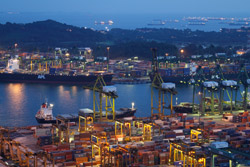
Manila, Philippines (BBN)- The Asian Development Bank’s (ADB) operations—comprising approvals of loans and grants, technical assistance, and cofinancing—reached an all-time high of US$27.15 billion in 2015, an increase of about 19 per cent over the $22.89 billion in 2014.
ADB’s approvals of loans and grants, sovereign (governments) and nonsovereign (primarily private sector), reached a record $16.58 billion—a 23 per cent increase from 2014, the ADB said in a press statement.
Technical assistance amounted to $144 million and co-financing increased by 13 per cent to a record $10.43 billion in 2015. Out of the $16.58 billion, sovereign loan and grant approvals increased by 21 per cent to $13.95 billion in 2015.
Nonsovereign approvals made a big leap from $1.92 billion in 2014 to $2.63 billion in 2015. In addition to a volume increase, ADB increased its allocation to the poorest countries to 40 per cent of nonsovereign approvals.
“To expedite small nonsovereign transactions, ADB introduced a fast-track approval process. ADB is now making active use of local currency lending to the private sector and increased bond issuances in local currencies to support the lending,” it noted.
Unless loans and grants are disbursed, they will have no impact on development. In 2015, total disbursements of loans and grants reached a record $12.34 billion, an increase of 21 per cent over the previous year.
“Our record performance last year reflected strong and growing demand from the Asian and Pacific region,” ADB President Takehiko Nakao said. “Infrastructure and other development needs are huge and poverty remains pervasive despite the region’s robust growth performance.”
To help meet the increased demand for its operations, ADB Board of Governors last year unanimously endorsed the merger of ADB’s concessional Asian Development Fund and its market-based ordinary capital resource balance sheet. With this path-breaking reform, ADB’s financing capacity (annual approvals of loans and grants) will dramatically increase up to $20 billion by 2020. ADB is well on track to achieve this scaling up.
Among ADB’s operational highlights last year were the quick response to natural disasters, especially the Nepal earthquake in April and the Vanuatu cyclone in March; and support for necessary fiscal measures of countries suffering from lower commodity prices and volatility in financial markets, such as Kazakhstan and Mongolia.
In 2015, ADB was among the first multilateral development banks to commit a sizable climate finance target. In late September, ADB announced it would double its annual climate financing to $6 billion by 2020, up from the current $3 billion.
To support its climate work, ADB issued its first green bond. ADB approved its first policy-based loan in the People’s Republic of China to improve air quality in the Beijing-Tianjin-Hebei area.
In order to help effectively mobilize financial resources and management skills from the private sector for infrastructure development, ADB established an Office of Public-Private Partnership (PPP). This office offered active transaction advisory services for PPP projects in the region such as the North-South Railway project in the Philippines.
The ADB made further progress in streamlining procedures for country programing, project processing, and procurement. One example was the introduction of tailor-made procurement procedures specifically for small Pacific Island countries. It has been providing greater resources and delegating more authority to its 31 field offices to improve its responsiveness on the ground.
The ADB, based in Manila, is dedicated to reducing poverty in Asia and the Pacific through inclusive economic growth, environmentally sustainable growth, and regional integration. Established in 1966, it is owned by 67 members—48 from the region.
BBN/SSR/AD